The War Memorial for the popular holiday town of Saundersfoot sits on the road junction between Saundersfoot, New Hedges and Amroth, outside St. Issell’s Church. The Memorial takes the form of a Celtic cross, carved in stone, with marble name panels attached to it, which commemorate the men of both World Wars from the area. Situated inside the church are two separate wooden panels, which bear the same names as are on the cross.
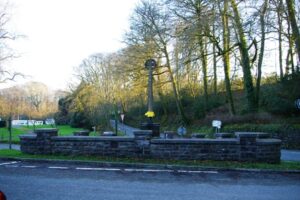
The Great War, 1914-1918
William George Bennett, Engine Room Artificer 3rd Class, M4301, Royal Navy. William was born on 4 November 1890, the son of Richard William and Amy Rixon Bennett, of Cartier, Saundersfoot. He served aboard the modern Battlecruiser HMS Queen Mary, which was attached to the 1st Battlecruiser Squadron of the Grand Fleet. Built by Palmers, she was launched in 1912. HMS Queen Mary took part in the Battle of Heligoland Bight, the Battle of Dogger Bank, before taking part in the Battle of Jutland on 31 May 1916. During the early stages of the Battle, Queen Mary received several direct hits from the German ships Seydlitz and Derfflinger, and blew up with the loss of 1,266 of her crew. Only nine men survived the explosion. One of the unfortunate men killed aboard her was William, who was 25 years old. He is commemorated on the Portsmouth Naval Memorial, Hampshire.
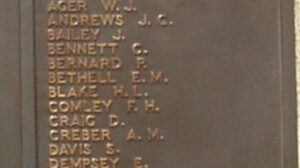
William Henry Bodill, Bandsman, 5629, 10th Prince Of Wales’ Own Royal Hussars. William was the son of William and Charlotte Elizabeth Bodill, of Folkestone, Kent. He was residing in Saundersfoot prior to the outbreak of war, and enlisted at Cardiff into the 10th Prince Of Wales’ Own Royal Hussars, who were stationed in South Africa at the start of the war. In August, 1914 they sailed from Cape Town, and upon their arrival in England joined 6th Cavalry Brigade, 3rd Cavalry Division. On 8 October 1914 the Division landed at Ostend, where they fought during the Defence of Antwerp. The then moved to Ypres, where they took part in First Ypres, and in 1915 fought at Second Ypres and the Battle of Loos. They were in reserve on the Somme, waiting for the breakthrough that never came, when William was wounded. He was brought back to the Casualty Clearing Station, where he Died of Wounds on 10 October 1916, aged 25. He is buried at Contay British Cemetery, Contay, France.
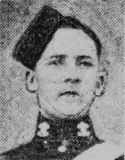
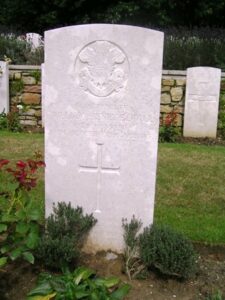
William George Phelps Brinn, Private, 48457, South Wales Borderers. William was the son of William Phelps Brinn and Martha Brinn, of St. Issell’s, Saundersfoot. He enlisted at Carmarthen into the Welsh Regiment, and was posted to France, probably late in 1917, joining the 10th Battalion, South Wales Borderers, who were attached to 115 Brigade, 38th (Welsh) Division. The Division had been in France since December 1915, and had taken part in two major battles, at Mametz Wood in 1916, and Pilckem Ridge in 1017. William probably joined the battalion as a reinforcement after the Pilckem Ridge battle, probably when the division was wintering in the Armentieres sector. When the German Spring Offensive fell upon the British Lines on the Somme on 21 March 1918, the Welsh Division was called upon to move to the Somme, and they took up positions around Aveluy Wood and Albert. They remained here for the next few months, fighting a desperate defence, before the tide of war turned, and the great advance began. The Welsh fought their way back across the Somme, to positions in front of the Hindenburg Line, and fought in the final battles here to capture positions from which the Allies could launch their final attacks on the mighty Hindenburg Line. William was Killed in Action here whilst attached to the 115th Trench Mortar Battery, during the Battle of Épehy, on 18 September 1918, aged just 19. He is buried at Gouzeaucourt New British Cemetery, France.
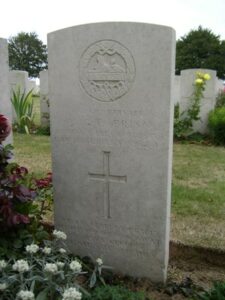
William Charles Chapple, Gunner, 371273, Royal Garrison Artillery. William was the son of Henry Thomas and Mary Ann Chapple, of 5, Ridgway, Saundersfoot. He enlisted at Saundersfoot into the Royal Garrison Artillery, but little else is known of his service. William Died on 28 December 1917, aged 19. For some reason, the location of his grave is unknown, and William is commemorated on the Hollybrook Memorial, Southampton.
John Childs, Sergeant, 146696, Royal Garrison Artillery. John was the son of John and Frances Childs, of Backe, Saundersfoot. He enlisted in Saundersfoot into the Pembrokeshire Battery of the Royal Garrison Artillery. At a later date he transferred into the 306th Siege Battery, Royal Garrison Artillery. It is not known at present when John arrived on the Western front, but John was wounded during the initial bombardments of the Third Battle of Ypres, and was taken to the Casualty Clearing Station at Proven, where he Died of Wounds on 29 July 1917, aged 27. He is buried at Mendinghem Military Cemetery, Belgium.
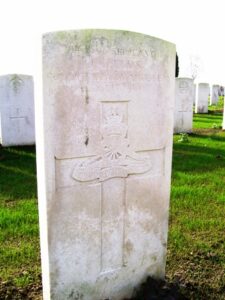
Alfred George Collins, Gunner, 617, Royal Garrison Artillery. Alfred was the son of Thomas Langley Collins and Martha Collins, of Coppit Hall, Saundersfoot. He had married prior to the war, and resided with his wife Martha Ann Collins, at Churchton, Saundersfoot. Alfred had enlisted at Saundersfoot into the Pembroke Company of the Royal Garrison Artillery. Little else is presently known about Alfred, but he sadly died at home on 1 August 1916, aged 26. Alfred is buried at St. Issell’s Cemetery, Saundersfoot.
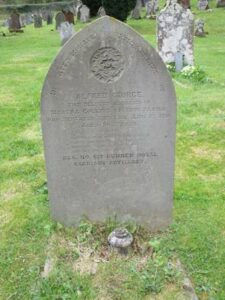
Francis David, Lance Corporal, 30780, Welsh Regiment. Francis was the son of John and Emily Louisa David, of Eastcliffe, Saundersfoot. Francis enlisted at Pembroke into the 1st Battalion, Welsh Regiment, which were stationed in India at the outbreak of war. They returned swiftly back to England, where they joined 84 Brigade, 28th Division, and landed at Havre on 1 January 1915. Here they moved to Flanders, and fought throughout Second Ypres, where the Division suffered terrible casualties. They then moved south, taking up positions around Loos, and Francis was Killed in Action during the Battle of Loos, on 2 October 1915, aged 23. He is commemorated on the Loos Memorial, France.
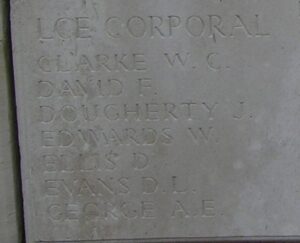
Benjamin Davies, Private, 552600, Princess Patricia’s Canadian Light Infantry. Benjamin was born at Saundersfoot on 14 May 1880, the son of John and Sarah Davies. He had served with the Pembroke Yeomanry prior to migrating to Canada prior to the war and worked as a Barber at Alberta. He enlisted on 26 April 1915 into the 13th Canadian Mounted Rifles and embarked for England in July 1916, joining the Princess Patricia’s Canadian Light Infantry (Eastern Ontario Regiment). He does not appear to have served on the Western Front, but remained at Seaford Camp before being sent back to Canada on 18 July 1917 after becoming ill. He died of tuberculosis in Calgary on 17 March 1919, aged 38, and is buried in Calgary Union Cemetery, Canada. Benjamin is not commemorated at Saundersfoot.

Joseph Davies, Private, 14040, Kings Shropshire Light Infantry. Joseph was born in Saundersfoot in 1891, the son of Joseph and Mary Davies. The family later resided at St. Mary’s Hill Cottage, Tenby. Joseph enlisted at Merthyr Tydfil into the 7th Battalion, King’s Shropshire Light Infantry, which was formed at Shrewsbury in August 1914. The Battalion was attached to 76 Brigade, 25th Division, and on 28 September 1915 landed at Boulogne. The Brigade then transferred to 8 Brigade, 3rd Division. Joseph first saw action in the trenches in Flanders, where the Division remained through the first half of 1916, fighting at the Bluff and St. Eloi Craters. They then moved south to take part in the Somme Offensive, which is where Joseph was Killed in Action during the Battle of Albert on 14 July 1916, aged 25. He is commemorated on the Thiepval Memorial, France.

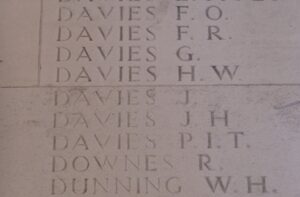
Sidney Davies, Private, 583500, Labour Corps. Sidney was the son of John and Mary Davies, of Scar Farm, Saundersfoot. Sidney was serving with the Pembrokeshire Royal Garrison Artillery at the outbreak of war, but transferred into the Pembroke Yeomanry, with the number 4929, serving in Egypt with the 24th Battalion, Welsh Regiment, with the number 320417. He was invalided home from Egypt on 21 December 1917, suffering from malaria, joining the Labour Corps. After a long spell of illness, and treatment at Fazakerly Hospital, Liverpool, Sidney was discharged from the army on 31 January 1919. He died of tuberculosis at Llanelli on 2 May 1919, aged 23, and is buried at St. Issell’s Cemetery, Saundersfoot.
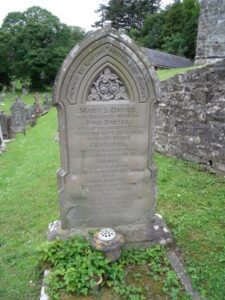
William Griffiths, Private, 2141, Welsh Guards. William was the son of Benjamin and Rachel Griffiths, of Saundersfoot. He enlisted at Pembroke into the 1st Battalion, Welsh Guards, who were attached to the 3rd Guards Brigade, Guards Division. The Division had formed in France during August, 1915, and saw its first action at the Battle of Loos. In July, 1916 they moved to the Somme, and fought at the Battles of Flers-Courcelette and Morval. William was Killed in Action at Ginchy on 10 September 1916, aged 27, and is buried at London Cemetery and Extension, Longueval, France. The CWGC list his next of kin as his brother John Griffiths, of Jeffreyston.
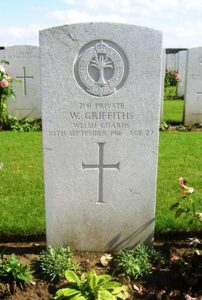
Edward Haydn Harries, Private, T/362594, Army Service Corps. Edward was born in Swansea, the son of David and Mary Harries. He was the husband of Lillian May Harries, of Morcroft, Saundersfoot. Edward had served with the Army Service Corps, at the M.T. Depot, Grove Park, and died at the Royal Herbert Hospital at Woolwich on 2 November 1918, aged 32. Edward is buried at Swansea (Oystermouth) Cemetery, Edward is not commemorated locally.
Henry Howells, Able Seaman, Mercantile Marine. Henry was born at Saundersfoot, the son of George and Sarah Howells, and served in the Mercantile Marine, aboard S.S. “Middleton”, a Hull registered ship. On 30 November 1917, Middleton was en-route from Mudros to Alexandria, with a cargo of sand-bags, when she was attacked and shelled by the German submarine U-39. Henry was the only member of her crew killed during the attack that day, the remainder escaped by lifeboat, where a further three men later died of wounds. Henry was 58 years old, and is commemorated on the Tower Hill Memorial, London.
Wynne Odyerne Hulm, Lieutenant, Devonshire Regiment. Wynne was born on 8 August 1888, the son of Wynne Patrick Hulm and Elizabeth Hulm (nee Lever), of 124, Finborough Road, West Brompton, London. Wynne worked as a Bank Clerk prior to the war, and joined the Artists Rifles in 1908. He was commissioned into the 8th Battalion, Devonshire Regiment on 17 September 1914. The battalion was attached to 20 Brigade, 7th Division. The battalion landed in France on 26 July 1915, and had been attached to this already battle-hardened Division to gain experience. On the morning of 25 September 1915, the Battle of Loos opened, and Wynne’s battalion took part in the opening assault. During the charge across No Man’s Land, Wynne was hit by shell fragments, which severely wounded him. Wynne was carried to the dressing station at Lapugnoy where he died of his wounds within an hour, that same day. He was 27 years old, and is buried at Lapugnoy Military Cemetery, France.
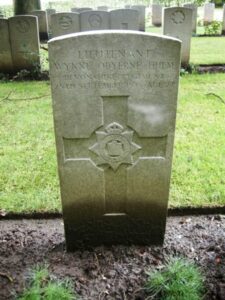
William Jackson, Private, 20337, Connaught Rangers. William resided at Kilvelgy, Begelley prior to the war. He enlisted at Carmarthen into the Pembroke Yeomanry. Some time later he transferred to the 3rd Battalion, Connaught Rangers, who were a Reserve Battalion. The Battalion had been stationed in Ireland for most of the war, and moved to Newcastle in November, 1917. They then moved to Dover in May 1918 where they remained for the duration of the war. William died on 11 November 1918, the day the Armistice was signed, and is buried at Begelley (St. Mary) Churchyard.
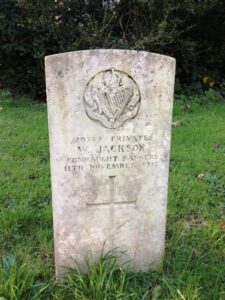
Hubert John Jenkins, Gunner, 620, Royal Garrison Artillery. Hubert was the son of Thomas and Martha Jenkins, of Hill, Saundersfoot, and had enlisted at Saundersfoot into the Royal Garrison Artillery. He was posted to their 114th Siege Battery, which was formed at Pembroke Dock on 3 March 1916. The Battery moved to France on 14 June 1916 equipped with 6 inch Howitzers. They moved to the Somme, where they took part in the great offensive from July 1916 onwards, and Hubert was Killed in Action on the Somme on 4 November 1916, aged 22. He is buried at Guillemont Road Cemetery, Guillemont, France.
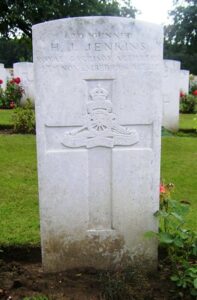
John Lewis Jenkins, Gunner, 371277, Royal Garrison Artillery. John was born at Penally in 1898, the son of Lewis and Selina Jenkins. The family later resided at Treberth Farm, Saundersfoot. John enlisted into the Royal Garrison Artillery, and was posted to their 409th Siege Battery, which was attached to the Third Army. John was wounded during Third Ypres, and brought to the Casualty Clearing Station at Vlamertinghe, where he died of wounds on 17 September 1917, aged 19. He is buried there, in Vlamertinghe New Military Cemetery, Belgium.
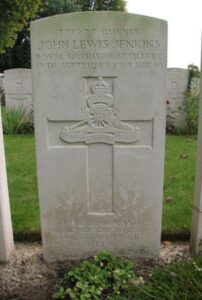
David Lloyd Jones, Private, 65115, Welsh Regiment. David was born in Saundersfoot in 1882, the son of Thomas and Martha Jones. By 1901 the family had moved, and resided at Lan Farm, Llansamlet. David married Ethel Maud Martin on 8 February 1912, and the couple resided at Swanfield Villas, Baglan, Briton Ferry, where their daughter Martha Thelma Jones was born on 20 June 1914. David enlisted there into the Welsh Regiment on 11 November 1915. David served with the Depot Battalion, on Home Service throughout the war. He became ill with influenza on 20 October 1918, and was admitted to the 3rd Western General Hospital at Cardiff, where he died on 8 November 1918, aged 36. David is buried at Baglan (St. Catherine) Churchyard. David is not commemorated locally.
Arnold Cecil Ewart Lewis, Private, 35027, Welsh Regiment. Arnold was the son of Benjamin and Elizabeth Lewis, of Pontycymmer, Garw Valley, Glamorgan. Benjamin and Elizabeth were both from Saunderfoot, and had moved to Pontycymmer looking for work, which is where Arnold was born. Sadly, when Arnold was just six years old his parents died from TB, and so Arnold and his sister Elizabeth went to live with their Aunt and Uncle Bill and Ann Frost, in Stammers, Saunderfoot. Arnold lived there until enlisting at Bridgend into the Army, and he was posted to the 15th Battalion, Welsh Regiment. The 15th Welsh had been formed during October 1914 as the Carmarthen Pals Battalion, and moved to Rhyl for training. They became part of 114 Brigade, 38th (Welsh) Division the following year, and moved to France during December, 1915 and moved to positions near Richebourg, in French Flanders. This was known as the ‘Nursery Sector’ where new units were blooded into trench life, and after an initial, relatively quiet spell in the lines, the Division moved further south during the Spring of 1916, taking up positions near Ginchy. It was here that Arnold lost his life, when he was killed on 9 March 1916. Arnold was just 22 years old, and is buried at Guards Cemetery, Windy Corner, Cuinchy, France. Many thanks to David Harries for the information and photographs.
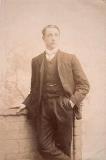
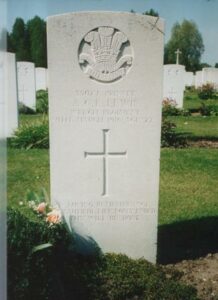
John Claude Murray, Second Lieutenant, South Wales Borderers. John was born in 1884, the son of William and Elizabeth Murray, of Treberth Farm, Saundersfoot. He was commissioned into the 2nd Battalion South Wales Borderers, who were in Tientsin, China at the outbreak of War. After a famous encounter with German forces at Lao Shan, they returned to Hong Kong, where they embarked for the U.K. on 4 December 1914. They arrived at Plymouth on 12 January 1915, and here they were attached to 87 Brigade, 29th Division. The Division sailed from Avonmouth on 16 March 1915 and landed at Egypt, from where they embarked to Mudros on the 10th April. They landed at Cape Helles, Gallipoli, on 25 April 1915, and remained there for the duration, suffering heavy casualties. On 2 January 1916 the Division was withdrawn from Gallipoli, and landed at Marseilles (via Egypt) on 29 March 1916. The division took up the line opposite Beaumont Hamel, on the Somme, soon afterwards, and began preparations for its part in the forthcoming offensive there. The 2nd South Wales Borderers took part in the initial offensive of 1 July 1916, but lost half its men either killed, wounded or missing within minutes. John was among nine officers of the battalion posted as missing that morning. He was later judged to have been killed in action, but for some reason the official date of his death is 9 July 1916, a week after the battalion was relieved and moved into reserve. The 31-year-old has no known grave, and is commemorated on the Thiepval Memorial, France.

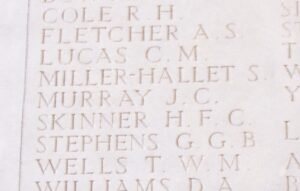
Charles Ormond, Engine Room Artificer 3rd Class, 271703, Royal Navy. Charles was born on 23 January 1889, the son of John and Martha Ormond, of the Cambrian Hotel, Saundersfoot. He served as a pre war regular in the Royal Navy, aboard H.M.S. Defence. Defence was a Minotaur Class Armoured Cruiser, and was stationed in the Mediterranean at the start of the war. She became the flagship of the First Cruiser Squadron, and took part in the Battle of Jutland. During the height of the Battle, the Defence was closing in on the crippled SMS Wiesbaden, when she was hit by a German salvo in the magazine. She blew up and sank almost immediately, taking down with her the entire crew of 903 men. Charles was 27 years old when he was killed in the sinking of Defence on 31 May 1916. He is commemorated on the Plymouth Naval Memorial, Devon.
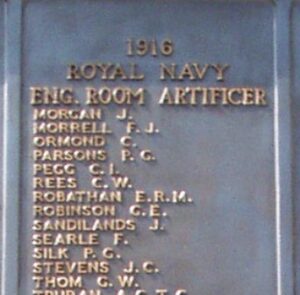
Alfred George Prout, Private, 73683, Machine Gun Corps. Alfred was born in Saundersfoot in 1894, the son of Margaret Prout. He had moved with his family to 31, Ely Street, Tonypandy, after their mother had remarried in 1906. Alfred and Phillip enlisted at Carmarthen into the Pembroke Yeomanry on 7 February 1916. Alfred was transferred to the Welsh Regiment, and later transferred into the 3rd Company, Machine Gun Corps, who were attached to the 1st Division. The Division had been in France since the beginning of the war. In 1916 the Machine Gun Companies were formed prior to the Somme Offensive, by forming the trained Machine Gunners from the Infantry Battalions into dedicated Machine Gun Units. Alfred fought throughout the Somme Offensive with the Division, and then in the advance to the Hindenburg Line in March 1917. Later that year they moved north to take part in an offensive on the Flanders Coast, but the Battle of Third Ypres stagnated in the Flanders mud, and the division was rushed to Ypres. Alfred was wounded during the Second Battle of Passchendaele, and sadly died of wounds on 10 November 1917. He is buried at Dozinghem Military Cemetery. His brother Philip had been killed just weeks earlier. Neither brother is commemorated at Saundersfoot.
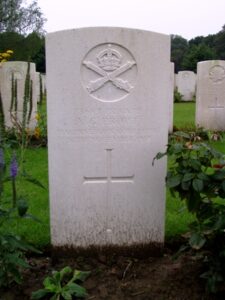
Philip John Prout, Private, 56938, Welsh Regiment. Philip was born in Saundersfoot in 1896, the son of Margaret Prout. He had moved with his family to 31, Ely Street, Tonypandy, after their mother had remarried in 1906. Philip and Alfred enlisted at Carmarthen into the Pembroke Yeomanry on 7 February 1916. Philip was posted to France on 5 August 1916, and was posted to the 13th Battalion, Welsh Regiment, who were attached to 114 Brigade, 38th (Welsh) Division. The Division had been in France since landing in December 1915, and moved to positions near Armentieres. They moved south in June 1916, and then fought on the Somme, where they had famously captured Mametz Wood. The Division suffered heavy losses at Mametz, and moved via Hebuterne to positions at Boesinghe, north of Ypres. They remained here for the next twelve months, until taking part in the opening attack of the Third Battle of Ypres. Philip was killed in action during the Battle of Pilckem, on 31 July 1917, aged 21. He is commemorated on the Ypres (Menin Gate) Memorial, Belgium. Alfred was killed within weeks of Philip. Neither brother is commemorated at Saundersfoot.
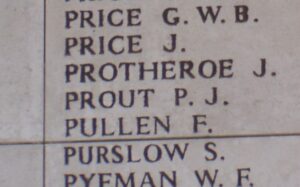
Charles Richards, Gunner, 358, Royal Garrison Artillery. Charles was the son of George and Mary Richards, of Griffithston Hill, Saundersfoot, and had enlisted at Saundersfoot on 10 January 1912 into the Pembrokeshire Battery, Royal Garrison Artillery. He served with No. 2, Pembroke Company, which was a Home Service unit. Charles sadly died at home of meningitis on 23 June 1916, aged 21. Charles is buried at St. Issell’s Cemetery.
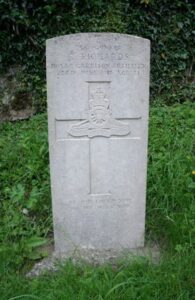
Charles Seabourne, Private, 63259, Welsh Regiment. Charles was born at Abergavenny in 1893, the son of John and Emily Seabourne. The family later moved to Brays Moor Farm, Saundersfoot at some time prior to 1901. Charles enlisted at Tenby into the Cheshire Regiment. He later transferred into the 17th Battalion, Welsh Regiment, who were attached to 119 Brigade, 40th (Bantam) Division, and in June 1916 landed in France. They moved to the Somme, and fought during the latter end of the Somme Offensive, at the Battle of the Ancre. They followed the German retreat to the Hindenburg Line in March 1917, and remained in the area until taking part in the Battle of Cambrai later in the year. They were still in the area when the German Spring Offensive hit in March, 1918, and fought at the Battles of St. Quentin and Bapaume, before being moved to Flanders to rebuild. However, in February 1918 the 17th Welsh were disbanded, and Charles was posted to Hood Battalion, Royal Naval Division. On 5 June 1918 Charles was officially shown as having transferred to the 14th Welsh, but remained with Hood Battalion. Charles was badly wounded after being shot in the thigh during the attack against the Hindenburg Line, and died of his wounds on 30 September 1918, aged 25. He is buried at Hermies Hill British Cemetery, France. The headstones here are very badly worn, and almost illegible.
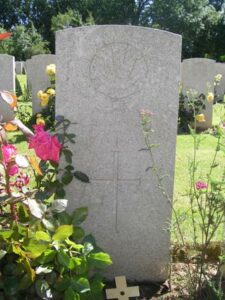
Garfield Stanley Sainsbury Silcox, Private, 425314, Canadian Infantry. Garfield was born at Saundersfoot on 8 November 1888, the son of James Henry and Sarah Jane Silcox. The family later lived at Pembroke Dock, before moving to Skeena, Park View, Swansea. Garfield emigrated to Canada, where he worked for the Grand Trunk Pacific Railway. He enlisted at Winnipeg on 1 September 1915 into the 45th Battalion, Canadian Infantry, and arrived in England on 25 March 1916. Garfield then landed in France on 25 May 1915, where he was posted to the 2nd Canadian Mounted Rifles, which was attached to the 8th Brigade, 3rd Canadian Division. Garfield joined his new unit in time to take part in the Battle of Mount Sorrel. The Canadians then moved to the Somme, and took part in the Battle of Flers-Courcelette, and the Battle of Thiepval during September 1916. On 1 October 1916 the Battle of Le Transloy was launched, and Garfield was killed here on 9 October 1916, aged 29. He is commemorated on the Vimy Memorial, France. Garfield is not commemorated locally.
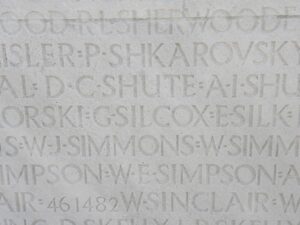
Joseph Slaymaker, Battery Sergeant Major, 1478, Royal Garrison Artillery. Joseph was born in 1875, the son of Joseph and Ellen Slaymaker, of Wheatley, Oxfordshire. He was a long serving soldier, and married Margaret Elizabeth Richards, of The Valley, Saundersfoot in 1905. Sadly nothing is known of any details of his service, except that he had served in Salonika with the 84th Siege Battery, Royal Garrison Artillery, and had been taken prisoner of war at some time. Joseph sadly died of sickness contracted whilst being interned on 20 November 1918, age 42. He is buried at Sofia War Cemetery, Bulgaria. Many thanks to Adrian Wright for the photograph.
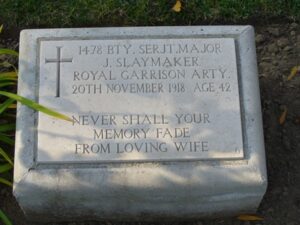
Albert Thomas, Gunner, 371257, Royal Garrison Artillery. Albert was the son of John Thomas and Sarah Jane Thomas (nee Davies), of Sandy Hill, Saundersfoot. He worked with his father as a collier before enlisting at Tenby into the Royal Garrison Artillery, and was posted to the 323rd Siege Battery, Royal Garrison Artillery. From 21 August 1918 the Allies launched a massive assault along their front in the Somme sector, due to a successful assault to the south, at Villers-Bretonneux, on 8 August, and began pushing the Germans back towards the Hindenburg Line. Albert was killed in action during the drive from Arras towards Cambrai and the daunting Hindenburg Line defences there, on 1 September 1918, aged 22. He is buried at Wancourt British Cemetery, France.
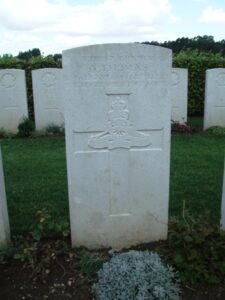
Benjamin Thomas, Gunner, 371182, Royal Garrison Artillery. Benjamin was the son of Benjamin and Mary Thomas, of Picton House, Saundersfoot, and enlisted at Hubberston into the Royal Garrison Artillery. He was posted to their 114th Siege Battery, and moved to the Western Front. Benjamin was killed in action during the Arras Offensive, at the Battle of Vimy Ridge on 10 April 1917, aged 25. He is buried at Bois-Carre British Cemetery, Thelus, France.
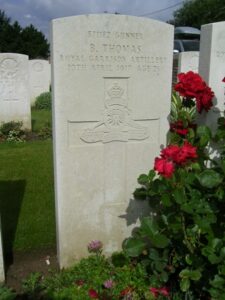
Samuel Mervyn Williams, Second Lieutenant, Notts & Derby (Sherwood Foresters). Samuel was the son of Dr. Richard H. Williams and of Edith S. Williams, of Penfro, St. Bride’s Hill, Saundersfoot. Samuel was born in Pembroke Dock, and was educated at Llandovery, Plymouth and St. George’s College, Kingsway. He passed into Sandhurst on 18 January 1915 and was commissioned into the Sherwood Foresters on 15 August 1915. Samuel was then posted to their 2nd Battalion, which was attached to 71 Brigade, 6th Division, arriving on the Western Front on 4 October 1916. The Battalion had been in France since landing at St. Nazaire on 11 September 1914. They had rushed to reinforce the BEF on the Aisne, and had then been transferred to Hooge. In 1916 the Division moved south, to take part in the Somme Offensive, and fought at Flers-Courcelette, Morval and Le Transloy. Samuel had only gone into action for the first time on 13 October, but was killed in action just three days later, on 16 October 1916, aged 19, during the Battle of Le Transloy. He has no known grave, and is commemorated on the Thiepval Memorial, France.
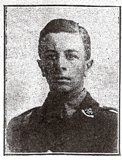
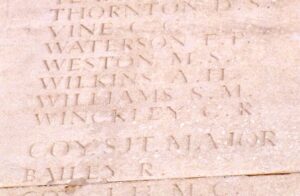
World War Two, 1939-1945
Bernard Ollin Badham, Stoker 2nd Class, D/KX. 164530, Royal Navy. Bernard was the son of William Ollin Badham and Doris Mary Badham, of Saundersfoot, and served with the Royal Navy aboard H.M.L.C.S.(L) 255. This was a Landing Craft, which was designated His Majesty’s Landing Craft Support (Small), No. 255. Bernard was killed during an accidental explosion at sea on 17 October 1943, aged just 20. He is buried at Saundersfoot (Bethesda) Presbyterian Church of Wales Chapelyard.
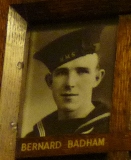
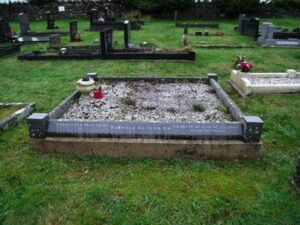
Geoffrey David Badham, Boy 1st Class, D/JX.171749, Royal Navy. Geoff was the son of William Ollin Badham and Doris Mary Badham, of Saundersfoot, and served in the Royal Navy, aboard HMS “Maori”. Maori was a Tribal Class destroyer that had been launched on 2 September 1937. She was involved in the pursuit of the Bismarck, and served with the 4th Cruiser Squadron, which was part of the Mediterranean Fleet, at the Battle of Cape Bon, off the coast of Tunisia during December, 1941. Geoffrey may have been injured during the Battle, as he died just days later at Alexandria, on 30 December 1941, aged just 17, and is buried at Alexandria (Hadra) War Memorial Cemetery. The Maori was finally sunk while anchored at Malta on 12 February 1942, when she went down with the loss of one crew member.
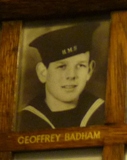
Ivor George Badham, Aircraftman 2nd Class, 1279531, Royal Air Force Volunteer Reserve. Ivor was the son of William and Annie Badham, of Kilgetty and served in the Royal Air Force Volunteer Reserve as an Aircraftman. Very little is known of his service, but he died on 21 May 1942, aged 24, and is buried at Middleton Holy Trinity Old Cemetery, Canada. Ivor must have been one of the thousands of Allied Airmen who had been sent to Canada to train, and was sadly one of the many who never returned. The Memorial erroneously lists him as being J. Badham.
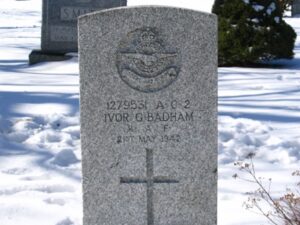
Charles John Westley Brinn, Sergeant (Observer), 563306, Royal Air Force. Charles was the son of John Melbourne Brinn and Rosa Brinn (nee Ormond), of Saundersfoot. He served in 59 Squadron, which was attached to Fighter Command. The Squadron had moved to France during October, 1939, equipped with Blenheim’s, and undertook reconnaissance missions in conjunction with the rapidly retreating BEF during those desperate few months in 1940, when they were being pushed back by the Germans towards Dunkirk. Charles died when his plane was shot down over France on 22 May 1940, and is buried at Fricourt Communal Cemetery, France, alongside his crew members. He was 28 years old. His mother Rosa had lost her brother Charles Ormond, of Tenby, during the Great War.
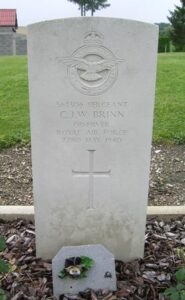
Robert Affleck Cuthbertson, Leading Stoker, P/KX 109403, Royal Navy. Robert was the son of Robert and Amy Sarah Cuthbertson. Robert served as a Leading Stoker with the Royal Navy, and in 1940 married Margaret Owens, of Saundersfoot. In October 1944 Robert joined the crew of the newly launched Minesweeper, HMS Vestal. In 1945 Vestal was deployed to the Pacific. On the evening of 26 July 1945, Vestal was attacked by a Japanese kamikaze plane, which crashed into the ship, causing severe damage. The surviving crew were taken off the stricken ship which was then scuttled, becoming the only British ship to be sunk by a kamikaze, and the last British ship to be sunk during WW2. Robert was 28 years old when he died that day, and is commemorated on the Portsmouth Naval Memorial, Hampshire. Robert is not commemorated at Saundersfoot.
Charles Llewellyn Davies, Sapper, 14527401, Royal Engineers. Charles was born at Saundersfoot in 1924, and had served during the war with the Royal Engineers. Little is yet known about him, except that he resided at Stammers Road, Saundersfoot. Charles died at Swansea Hospital on 5 September 1947, aged 23. He is buried at St. Issells Cemetery, Saundersfoot.
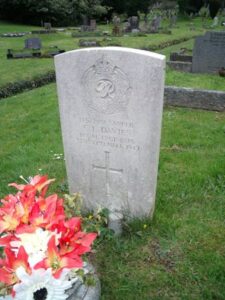
Charles Royston Davies, Gunner, 837579, Royal Artillery. Charles was the son of William Thomas Davies, and of Gertrude Hester Davies, of Saundersfoot, and served with the Royal Artillery. He was attached to their 9, Coast Regiment, which was stationed at Singapore, as part of the Coastal Defence. Charles was taken prisoner when Singapore fell to the Japanese on 15 February 1942. Charles died just days later, on 19 February 1942, aged 29, and is commemorated on the Singapore Memorial.
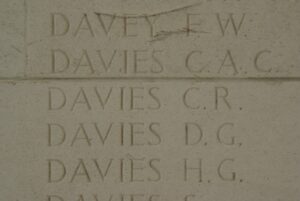
Dewi Madoc Davies, Sergeant, 1021734, Royal Air Force Volunteer Reserve. Dewi was the son of the Reverend David Davies and Catherine Ann Davies, of Saundersfoot. He was educated at Greenhill School, before enlisting into the Royal Air Force, and joined 228 Squadron, which operated the Short Sunderland, and was based at RAF Pembroke Dock. On 13 June 1943, Dewi was a crewman aboard Sunderland DV967 when she spotted a surfaced German Submarine, U564, and attacked her. Although badly damaging the U-Boat, the Sunderland was shot down, and crashed, killing all eleven of the crewmen aboard. Dewi was just 20 years old, and is commemorated on the Runnymede Memorial, Surrey. Dewi is not commemorated at Saundersfoot, but at his former School.
Frank Sidney Davies, Flight Lieutenant (Pilot), 79579, Royal Air Force Volunteer Reserve. Frank was born on 10 July 1906, the son of Arthur George And Maud Davies, of Southend-on-Sea. He married Alice Lilian Davies, of Woodford Bridge, Essex, in 1940. Fred trained as a Pilot prior to the war and gained his flying certificate on 16 May 1937 at Abridge Flying Club. When war broke out he joined the Royal Air Force Volunteer Reserve, and was posted to 595 Squadron, which formed at RAF Aberporth, on 1 December 1943, from 1607 Flight, 1608 Flight and 1609 Flight for anti-aircraft co-operation duties over central and northern Wales. It operated a variety of aircraft in this role, which included the Hawker Henley, Hawker Hurricane and Miles Martinet, the Henley and Martinet being two-seater target aeroplanes. Frank was Pilot on a flight from RAF Aberporth, most probably during a target firing exercise, when their Henley crashed on 15 December 1943, killing Frank and his Co-Pilot John Robertson. Frank was 37 years old, and is buried with John at St. Issells Cemetery, Saundersfoot. Neither men are commemorated on the St. Issells War Memorial.
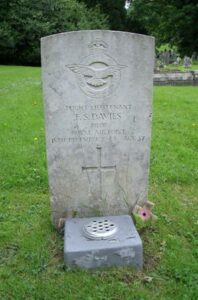
J. E. Ebsworth, Captain, Royal Air Force. The memorial shows a man called Captain J. E. Ebsworth, of the Royal Air Force among the WW2 names. The nearest local man who matches is shown below, although the rank and initials on the memorial are different:
John Josiah Baker Ebsworth, 579108, Cadet Pilot, Royal Air Force. John was born on 3 September 1926, the son of John Benjamin Thomas Ebsworth and of Dorothy Eveline Sophia Ebsworth (nee Baker), of Prospect House, Kilgetty. John married Sonia Flatau, of London, in 1947, just after joining the Royal Air Force. Within weeks of marrying, he was sent to attend the Rhodesian Air Training Scheme at RAF Heany in Southern Rhodesia to learn how to fly. John was killed in an accident at Buluwayo on 19 May 1948, aged 21. He is buried in Buluwayo (Athlone) Cemetery. His parents are buried at Zion Chapel, Begelly.
Greville Gascoyne Esnouf, Sergeant (Pilot), 929408, Royal Air Force Volunteer Reserve. Greville was the son of Reginald Vernon Esnouf and Violet Esnouf (nee Gascoyne), of Saundersfoot, and served with 35 Squadron RAFVR. 35 Squadron was reformed on 5 November 1940 at Boscombe Down, and equipped with the Halifax Bomber. Greville was Piloting Halifax L9527 (M) on a daylight bombing raid on 24 July, 1941, bound for the Battleship Scharnhorst, which was at anchor in Brest, when his plane was brought down over France. He was aged only 19, and is buried at Angles Communal Cemetery, France alongside four of his crew members. Two survivors were taken prisoner. Many thanks to John Leach for kindly sending in the photos of the memorial to the crew, at the crash site near Angles, and for the photo of Greville’s grave.
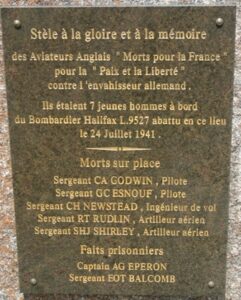
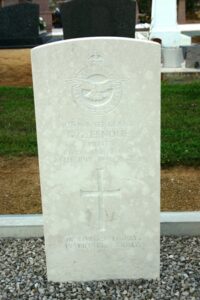
Albert William Flint, Corporal, 4603147, Duke of Wellington’s (West Riding Regiment). Albert was the son of Albert and Emma Flint, of Hednesford, Staffordshire. He married Martha Ellen Gough, of Saundersfoot, in 1932. Albert served with the 1st Battalion, West Riding Regiment. The battalion was sent to France at the outbreak of war, attached to 3 Brigade, 1st Division, and took part in the fighting retreat to Dunkirk. Albert was killed in Northern France on 30 May 1940, aged 38, and is buried at Les Moeres Communal Cemetery, France. Albert is not commemorated at Saundersfoot.
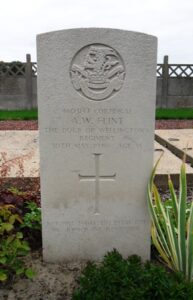
Gerald John Sandeman Gay, Lieutenant-Commander, Royal Navy. Gerald was the son of Levi John Albert and Isabel Maud Gay. He married Mary Herma Picton of Saundersfoot in 1933. He had worked his way up in the Royal Navy to Lieutenant-Commander, and served aboard HMS Gurkha. Gurkha was an ‘L Class’ Destroyer, which had originally been intended to have been named ‘Larne’, and had been renamed to Gurkha when the original ship of that name was sunk in April, 1940. She fought during the Commando Raid on the Lofoten Islands in 1941, and carried out escort duties with the Malta Convoys, where she was torpedoed by the U-133 off Sidi Barani on 17 January 1942. She sank in 90 minutes, and one of the men killed aboard her that day was the 32 year old Gerald. He is commemorated on the Plymouth Naval Memorial, Devon.
Christopher Edward A. Hobbs, Private, 23219756, Royal Army Medical Corps. Christopher was born at Saundersfoot on 10 March 1936, the son of Ernest and Caroline Hobbs. He served with the Royal Army Medical Corps. Christopher died at Singapore on 4 November 1956, aged 20. He was originally buried at Kranji Military Cemetery, Singapore, but it seems that his body may have been repatriated home for burial.
Colwyn Vivian Jackson, Corporal, 1006182, Royal Air Force Volunteer Reserve. Colwyn was born at Begelley in 1915, the son of William Jackson and of Martha Arm Jackson (nee Morris). He was brought up in Blackpool, Lancashire. Colwyn served with 208 Squadron, Royal Air Force, which was based in the Middle East, equipped with the Hawker Hurricane. Colwyn was despatched to Greece with the Squadron, in an attempt to bolster the Greek army during the German invasion of the country. The remnants of the Squadron returned to Egypt after Greece fell. Colwyn died in Egypt on 6 November 1942, aged 26, and is buried in Heliopolis War Cemetery, Egypt. His father William died during the Great War and is commemorated at Saundersfoot, but neither Colwyn nor his brother Elwyn who also fell during World War Two are commemorated locally.
Elwyn William Clement Jackson, Guardsman, 2734703, Welsh Guards. Elwyn was born in Begelley in 1919, the son of William Jackson and of Martha Arm Jackson (nee Morris). He was brought up in Blackpool, Lancashire. He was a regular soldier, and served with the 2nd Battalion, Welsh Guards at the outbreak of war. The 2nd Welsh Guards sailed for France on 22 May 1940, and disembarked at Boulogne, taking up defensive positions around the town, to enable evacuation of troops from Boulogne Harbour. Elwy was killed in action during the German attack on the town on 23 May 1940, aged 22. He is buried in St. Martin-Boulogne Communal Cemetery, France. His father William died during the Great War and is commemorated at Saundersfoot, but neither Elwyn nor his brother Colwyn who also fell during World War Two are commemorated locally.
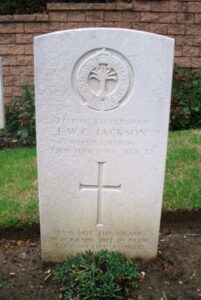
Albert Edward James, Leading Aircraftman, 942850, Royal Air Force Volunteer Reserve. Albert was the son of Albert John James and Ellen Ada James (nee Haddleton), of Evesham. He served with 271 Squadron, RAFVR. The Squadron had reformed at Doncaster in 1940, and was used in a Transport role, first flying the Handley Page Harrow, and then the Bristol Bombay. They flew in support of the BEF in France, and evacuated many troops from there. In 1942 the Squadron began training with the Airborne Forces, and were transferred to Transport Command, flying Dakota’s, and saw much service later in the war at D-Day and at Arnhem. Albert was killed when his Handley Page Harrow II, Serial K7005, crashed in poor weather in Donegal on 14 December 1943. He was 25 years old and is buried at Evesham Cemetery. (This is probably the correct man, as no-one else matches the details on the memorial).
Ernest Lloyd, Private, 4121433, The Cheshire Regiment. Ernest was the husband of Muriel Eliza Lloyd (nee Davies), of Saundersfoot. He served with the 2nd Battalion, Cheshire Regiment. The battalion was at Dunkirk in 1940, before sailing for the Middle East, and fought in the North African campaign. Ernest was killed in North Africa on 27 June 1940, aged 32, and is buried at El Alamein War Cemetery, Egypt. Ernest is not commemorated at Saundersfoot.
Kenneth John Morgan, Private, 14594437, The Welch Regiment. Kenneth was the son of John and Lena Morgan, of Woodside, and served with the 1/5th Battalion, The Welch Regiment. After spending the entire war training in the UK, the Battalion embarked for Normandy as part of the reinforcing troops after the landings of 6 June 1944, and landed in Arromanches between 26 and 28 June 1944, attached to 160 Brigade, 53rd (Welsh) Division. The Division remained in Reserve while they organised themselves, and were then rushed to take over from the 15th (Scottish) Division five miles west of Caen. The 1/5th Welch saw their first action here when they came under the attack of 105mm Howitzers, and suffered their first casualties, before being replaced by the 4th Welch on 3 July. On 18 July, the Battalion moved to positions at Hill 112 and the Le Bon Repos Crossroads, and over the next few days dug into positions here. On the morning of 21 July, the Germans brought reinforcements into the area opposing the Welch, and at 16.00 part of the Battalion, ‘A’ Company, was attacked by four Tiger Tanks of the S.S. Panzer Division. At 18.00 hours ‘B’ Company was overrun, and the British rushed four of their own tanks into the battle. One was knocked out almost immediately, and a lone stretcher bearer moved in to help a wounded crewman of the tank to safety, when the S.S. machine gunned them both whilst under a Red Cross Flag. At 20.00 ‘A’ Company reported more tanks closing in on them, and their last radio report came at 21.30, reporting the enemy as being 10 yards away. No more was heard of them, until 4 days later, when it was discovered that the whole Company had been wiped out that night. One of the men killed during this German counter-attack was Kenneth. He was Killed in Action on 21 July 1944 aged just 19, and is commemorated on the Bayeux Memorial, France.
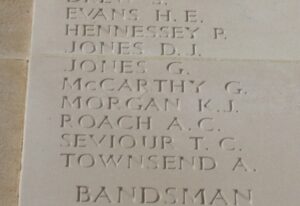
Sydney Mansel Rees Morris, Craftsman, 14550215, Royal Electrical and Mechanical Engineers. Sydney was the son of Sydney John and Elizabeth Ann Morris, and served with the Royal Electrical and Mechanical Engineers. Sydney had survived the rigours of the war in North West Europe, and had stayed in Germany as part of the British Army of the Rhine, as part of the Occupation Forces. Sadly he died in Germany aged 25 on 14 May 1947 and is buried at Munster Heath War Cemetery, Germany.
John Arthur Hugh Geraint Pennant, Flight Sergeant (Pilot), 1387662, Royal Air Force Volunteer Reserve. John was the son of Dyfrig Hughes Pennant and Rachel Pennant (nee Davies), of Saundersfoot. He married Elizabeth Thomson prior to the war. He served with 137 Squadron, RAFVR, which formed on 20 September, 1941 at RAF Charmy Down. They flew Whirlwinds as part of Fighter Command, and by June, 1943 re-equipped with the Hurricane IV, equipped with 40mm Cannons and rockets. In January, 1944 they changed to the Hawker Typhoon, and moved to France in June in support of the invasion of Europe, strafing retreating German troops and trains, and supported the Airborne Landings at Operation Market Garden. John was killed when his plane was shot down over Germany on 14 April 1945 aged 23, and is buried at Hanover War Cemetery, Germany.
William John Picton, Captain, 189399, The Welch Regiment. William was the son of Thomas Picton and Ada Matilda Picton (nee Cole), of Saundersfoot. He married Julia Nicholls of Saundersfoot in 1935 and served with the 1/5th Battalion, The Welch Regiment. After spending the entire war training in the UK, the Battalion embarked for Normandy as part of the reinforcing troops after the landings of 6 June 1944, and landed in Arromanches between the 26 and 28 June 1944, attached to 160 Brigade, 53rd (Welsh) Division. The Division remained in Reserve while they organised themselves, and were then rushed to take over from the 15th (Scottish) Division five miles west of Caen. The 1/5th Welch saw their first action here when they came under the attack of 105mm Howitzers, and suffered their first casualties, before being replaced by the 4th Welch on 3 July. On 18 July, the Battalion moved to positions at Hill 112 and the Le Bon Repos Crossroads, and over the next few days dug into positions here. On the morning of 21 July, the Germans brought reinforcements into the area opposing the Welch, and at 16.00 part of the Battalion, ‘A’ Company, was attacked by four Tiger Tanks of the S.S. Panzer Division. At 18.00 hours ‘B’ Company was overrun, and the British rushed four of their own tanks into the battle. One was knocked out almost immediately, and a lone stretcher bearer moved in to help a wounded crewman of the tank to safety, when the S.S. machine gunned them both, whilst under a Red Cross Flag. At 20.00 ‘A’ Company reported more tanks closing in on them, and their last radio report came at 21.30, reporting the enemy as being 10 yards away. No more was heard of them, until 4 days later, when it was discovered that the whole Company had been wiped out that night. One of the men killed during this German counter-attack was William, who was Killed in Action on 21 July 1944 aged 31, and is buried at Banneville-la-Campagne War Cemetery, France. The History of the Battalion remarks of the bravery of Captain Picton.
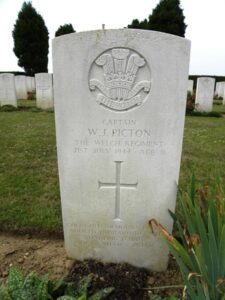
John Clement Rees, Private, 852820, Suffolk Regiment. John was the son of John and Margaret Rees, of Saundersfoot,. He married Margaret Ann Morris, of Saundersfoot in 1941. He served with an unknown Battalion of the Suffolk Regiment, and died at Ulverston, Lancashire on 9 March 1944 aged 29. He is buried at Sardis Congregational Graveyard.
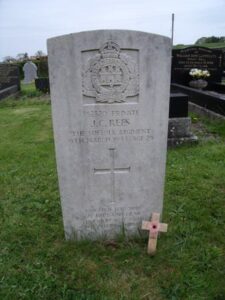
Thomas Henry Richards, Fusilier, 4205140, Royal Welch Fusiliers. Thomas was the son of William and Margaret Richards, of Saundersfoot. He married Sylvia Olive Waters, of Stepaside in 1940. He served with an unknown Battalion of the Royal Welch Fusiliers, and died on 19 October 1941 aged 25. He is buried in Sardis Congregational Graveyard.
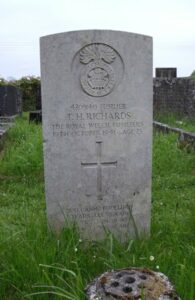
William Stanley Roberts, Signalman, 2566671, Royal Corps of Signals. William was the son of William Joseph and Lily Lucretia Maud Roberts, of Eglwysilan, Glamorgan, and the husband of Alice May Roberts, of Woodend, Saundersfoot. He served with 5 Lines of Communications Signals, Royal Corps of Signals. William was killed in Israel on 9 December 1944, aged 39, and is buried at Khayat Beach War Cemetery, Israel. William is not commemorated at Saundersfoot.
John Corry Robertson, Flying Officer (Pilot), 151588, Royal Air Force Volunteer Reserve. John was the son of John and Elizabeth Marguerite Robertson, and the husband of Margaret Strickland Robertson, of Erith, Kent. John served in the Royal Air Force Volunteer Reserve with 595 Squadron, which was formed at RAF Aberporth, on 1 December 1943, from 1607 Flight, 1608 Flight and 1609 Flight for anti-aircraft co-operation duties over central and northern Wales. It operated a variety of aircraft in this role, which included the Hawker Henley, Hawker Hurricane and Miles Martinet, the Henley and Martinet being two-seater target aeroplanes. John was Co-Pilot on a flight from RAF Aberporth, most probably during a target firing exercise, when their Henley crashed on 15 December 1943, killing John and his Pilot Frank Davies. John was 22 years old, and is buried with Frank at St. Issells Cemetery, Saundersfoot. Neither men are commemorated on the St. Issells War Memorial.
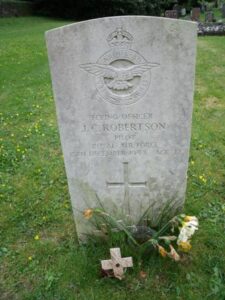
Sidney Benjamin Scourfield, Gunner, 1710050, Royal Artillery. Sidney was the son of Benjamin and Rosanna Scourfield, of Saundersfoot. He married Evelyn M Richards in 1927. He served as a Gunner with the 240th Battery, 77th Heavy Anti-Aircraft Regiment, Royal Artillery, who were en-route for the Middle East in 1942. They were instead diverted to Java, because of the Japanese offensive, and were then based in the Dutch East Indies. Sidney was captured by the Japanese sometime after arriving in Java, and sadly died on 19 November 1942, aged 36. He is commemorated on the Singapore Memorial, Column 29.
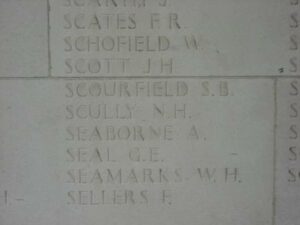
Charles John Sillick, Private, 4030701, King’s Shropshire Light Infantry. Charles was the son of James and Ellen Sillick. He married Lilian Joyce Evans of Saundersfoot in 1938. Charles served with the 1st Battalion, King’s Shropshire Light Infantry. The battalion was at Dunkirk, before being evacuated to Britain in May 1940. It sailed for North Africa in February 1943, taking part in the final advance against Tunis. The battalion then took part in the landings at Anzio, and it was there, on 24 February 1944, that Charles was killed. He was 33 years old and is buried at Beach Head War Cemetery, Anzio, Italy. His brother Thomas John Sillick also fell. Charles is not commemorated at Saundersfoot.
Thomas John Sillick, Signalman, 2576901, Royal Corps of Signals. Thomas was the son of James and Ellen Sillick, of Grange Town, Cardiff. He served with the 1st Airborne Division Signals, Royal Corps of Signals. Thomas sailed with the 1st Airborne Division for North Africa, and took part in Operation Torch in November 1942. After the Germans surrendered in North Africa the 1st Airborne took part in the Sicily landings, and then the main landings on Italy. Thomas was killed in Italy on 23 September 1943, aged 23, and is buried at Bari War Cemetery, Italy. His brother Charles John Sillick also fell. Thomas has no link with Saundersfoot apart from his sister-in-law, Lilian Joyce Sillick, so he is not commemorated at Saundersfoot.
William Frederick Royston Thomas, Gunner, 958867, Royal Artillery. William was born on 4 February 1918, the son of William John Owen Thomas and Martha Elizabeth Thomas (nee Ebsworth), of Sunny Back, Stepaside. He married Irene Richards in the autumn of 1941. William had worked as a heavy labourer prior to the war. He enlisted into the army and was posted to the 132nd (Welsh) Field Regiment, Royal Artillery, which was attached to the 8th Army, as part of the 78th (Battleaxe) Division. The Division formed specifically for Operation Torch, at Algiers in 1942, but William must have either have been wounded, or sent home ill, as he died in the Bridgend area on 3 May 1942, aged 24. His body was brought home and he was buried in Sardis Congregational Graveyard. William is not commemorated on the Saundersfoot Memorial.
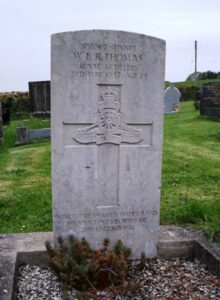
Norman Williams, Corporal, 7259144, Royal Army Medical Corps. Norman was the son of George and Elizabeth Williams, of Hill, Saundersfoot. He served with the Royal Army Medical Corps. Norman died on active service at Surrey on 16 April 1941, aged 32, and is buried in Sutton Cemetery, Surrey.